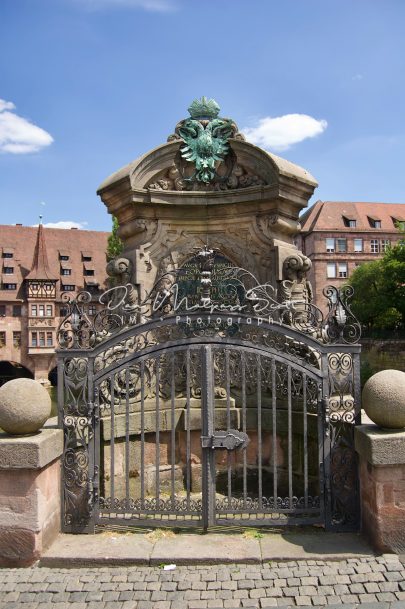![]()
Museumsbrücke, Nuremberg, Bavaria, Germany
The Museum Bridge (formerly Barfüsserbrücke) is a sandstone arch bridge that spans the Pegnitz in Nuremberg. The road bridge is located at the beginning of Königstrasse and connects the Nuremberg districts of St. Sebald and St. Lorenz. It is located between the main market and Lorenzer Platz.
The oldest bridge in Nuremberg over the Pegnitz is believed to be on the site of today’s museum bridge. A wooden bridge is documented for the 13th century. Since the structure connected the Franciscan monastery with the city, it was called the Barfüsser Bridge. However, floods repeatedly destroyed the bridge at this location in the following centuries. In 1484 a new building followed with stone substructures and a wooden superstructure.
In 1590 the building was again badly damaged by floods. Due to the ongoing maintenance work, the city decided in 1699 to replace the structure with a completely solid bridge. In 1700 the bridge was built with two stone arch openings and named after King Joseph I as Joseph’s or King’s Bridge. The Pegnitz crossing was decorated with two baroque pulpit structures with wrought iron grilles, which were arranged on the river pillar. The western structure is decorated with the coats of arms of the six members of the city government at the time.
In the 19th century, the name was changed to Museum Bridge because the “Museum” society, a social and reading society, owned a meeting house on the site of the former Barfüßerkirche.
The museum bridge was damaged by bombs during the Second World War. In 1954, as part of flood protection in the old town, the building was demolished and rebuilt. It was rebuilt with the appearance of 1700, but with double width and three openings. The construction costs were 500,000 DM.
The approximately 55 meter long arch bridge crosses the Pegnitz at an angle of approximately 80 degrees and has three circular segment arches, 0.8 meters thick in the span, with clear widths of 10.50 meters, 13.80 meters and 13.36 meters. The construction has been made of reinforced concrete since 1954, and the visible surfaces are clad with sandstone. The 19.8 meter wide road bridge is bordered on both sides by massive 0.9 meter high and 0.4 meter wide sandstone parapets on which stone balls made of quartzite with a diameter of 0.45 meter are arranged.
The width of the bridge results from the fact that it was part of a new north-south traffic axis. The wide street, which did not exist before the war and in which a tram was planned, leads from Maxtor via the fruit market, the museum bridge and the Lorenzkirche to the main train station. The space for this was created by no longer rebuilding the buildings that had been destroyed in the war or by rebuilding them with a withdrawn building line. Today the bridge, like all surrounding streets, is a pedestrian zone.


